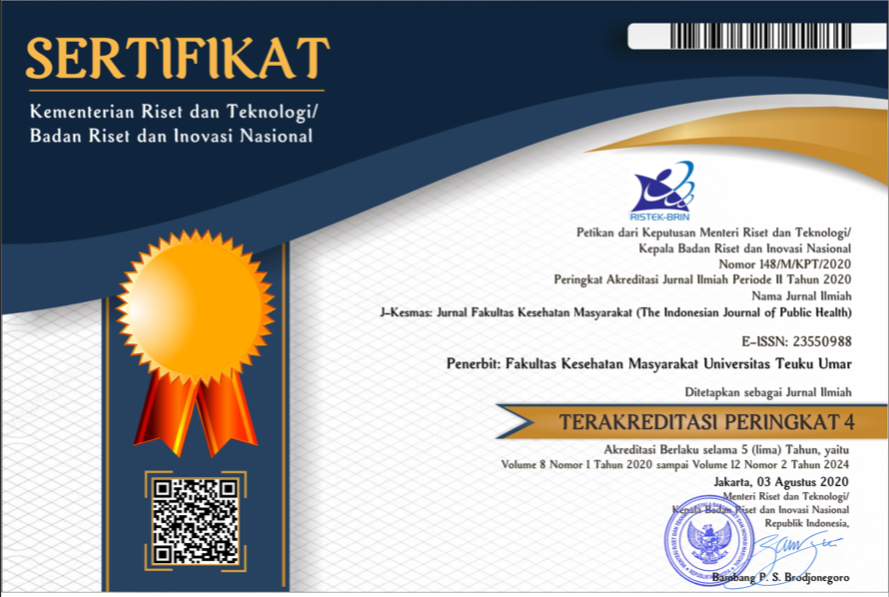Influence of Team Work on Employee Performance in Community Health Center of Pancoran Mas Depok West Java in 2019
Abstract
Keywords
Full Text:
PDFReferences
Mangkunegara, A. A., & Prabu, A. (2007). Manajemen Sumber Daya Manusia, Bandung: PT. Remaja Rosdakarya.
Bandow, D. (2001). Time to create sound teamwork. The Journal for Quality and Participation, 24(2), 41-47.
Cooper, R., & Sawaf, A. (1996). Executive EQ: Emotional intelligence in leadership and organizations. New York: Grosset/Putnam.
Creed, W. E. D., & Miles, R. E. (1996). Trust in organizations: A conceptualframework linking organizational forms, managerial philosophies, and the opportunity costs of controls. In R. M. Kramer & T. R. Tyler (Eds.) Trust in organizations: Frontiers of theory and research. Thousand Oaks, CA: Sage. 16-39.
Dewi. (2005). Pengaruh Pembagian Kerja Terhadap Efektivitas Kerja Pegawai pada Bagian Produksi PT Dupantex, Kabupaten Pekalongan. Skripsi FE Universitas Negeri Malang.
Dewi, Sandra. (2007). Teamwork (Cara Menyenangkan Membangun Tim Impian). Bandung: Progressio.
William, E. A., & Castro, S. L. (2010). The effects of teamwork on individual learning and perceptions of team performance: A comparison of face‐to‐face and online project settings. Team Performance Management. 16(3), 127-147.
Gibson, C. B., Gibbs, J. L. (2006). Unpacking the concept of virtuality: The effects of geographic dispersion, electronic dependence, dynamic structure, and national diversity on team innovation. Administrative Science Quarterly, 51(3), 451–495
Hosseini, M. R., Zuo, J., Chileshe, N., Baroudi, B. (2015). Evaluating virtuality in teams: A conceptual model. Technology Analysis & Strategic Management, 27(4), 385–404. doi:10.1080/09537325.2014.1003206
Jones, G., & George, J. (1998). The experience and evolution of trust: Implications for cooperation and teamwork. Academy of Management Review, 23(3), 531-546.
Maxwell, John, C. (2002). Mengembangkan Kepemimpinan di dalam Diri Anda. Penerjemah: Lyndon Saputra. Jakarta: Binarupa Aksara.
Ortiz de Guinea, A., Webster, J., Staples, D. S., (2012) . A meta-analysis of the consequences of virtualness on team functioning. Information & Management, 49(6), 301–308. doi:10.1016/j.im.2012.08.003
Robbins, Stephen P.; Judge, Timothy A. (2013)., Organizational Behaviour., fifteenth edition by Pearson Education, Inc., Publishing as Prentice Hall, United States of America.
Simons, T. L., & Peterson, R. S. (2000). Task conflict and relationship conflict in top management teams: The pivotal role of intragroup trust. Journal of Applied Psychology, 85, 102- 111.
Sutanto Priyo Hastono. (2018). Analisis Data pada bidang Kesehatan. Depok: Rajawali Pers.
Tangkilisan, Nogi Hessel. (2005). Manajemen Publik. Jakarta: PT. Gramedia Widiasarana.
Watson-Manheim, M. B., Chudoba, K. M., & Crowston, K. (2012). Perceived discontinuities and constructed continuities in virtual work. Information Systems Journal, 22(1), 29–52. doi:10.1111/j.1365-2575.2011.00371
West, Judge. (2002). Team Work. Jakarta: Prestasi Pustaka,
Webber, S. S. (2002). Leadership and trust facilitating cross-functional team success. Journal of Management Development, 21(3), 201-214.
Williams, P. (2008).The Magic of Team Work (alih bahasa JJ. Waskito Trisnoadi). Jakarta: Penerbit PT. Grassindo
DOI: https://doi.org/10.35308/j-kesmas.v7i2.2609
Refbacks
- There are currently no refbacks.
Managed by Fakultas Kesehatan Masyarakat
Published by Universitas Teuku Umar
Website: http://jurnal.utu.ac.id/jkesmas
Email: jkemas@utu.ac.id 
This work is licensed under a Creative Commons Attribution-ShareAlike 4.0 International License.







.jpg)


